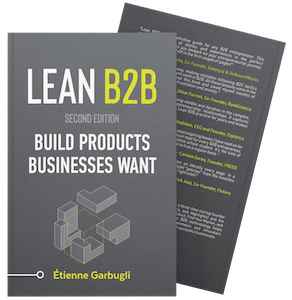Through Lean B2B: Build Products Businesses Want, I get to talk with a lot of smart and ambitious founders.
They’ve either begun by building a MVP or by doing customer discovery within their relevant network, and because their end-game is enterprise, the opportunity only seems to make sense to large organizations or they’re hoping to gain legitimacy with key lighthouse customers, they decide to go enterprise-first.
Although large companies like Taleo and Vontu have been built enterprise-first, my advice to founders is always to start smaller by targeting small and medium businesses.
Here’s why:
- The learning cost is higher: In the enterprise, there’s more steps just to be able to have meaningful discussions: you need to get through the door, understand the buyer groups, the decision-making process, the industry and build an early adopter network.
- You front-load risk: Investors–especially in B2B–don’t typically want to fund customer development. It’s likely that everything you do prior to landing your first few customers will be pre-funding, on your own dime.
- You need a longer runway: The longer the sales cycle, the longer it will take to land your first customers, and the more cash you’ll need to tough it out. To survive, you want to reduce the time it takes to get early sales as much as possible.
- It’s harder to gain momentum: As a B2B founder, your chance of success is related to the proximity you’re able to have with your early adopters and your ability to react/adapt to their feedback. It’s much harder to get fast feedback loops going in the enterprise where stakeholder groups are larger.
- You’ll likely have to build too much: As Atlassian Head of Design Karen Cross said, in enterprise, it’s often about designing for the 100%. Without understanding the whole product, you won’t get customers to truly buy in.
Going for the big enterprises first is riskier. It takes longer to build a base of revenue and get the metrics you need to raise funding. In most cases, it’s enterprise or bust.
Enterprise B2B Software is Hard
At the time when I joined Psykler, they had a working product, several mid-to-large businesses in the pipeline, and the basis for a customer development panel. We had 10 months of runway and were committed to enterprise-first–as the software needed large sales teams to truly be valuable.
We had to retain our early customers, reach product-market fit and raise capital just to survive.
As fast as we thought we could get there, we needed a significant acceleration event to succeed.
In the end, it didn’t happen and we ran out of cash.
To go enterprise-first, you need sufficient runway to reach product-market fit, get early sales and raise money. If you don’t, your startup is probably already dead… and you just don’t know it.
Selling to small businesses is a great way to start a business. You can go up-market anytime once the business has been validated.
More on Big Enterprises
- Is Bottom Up SaaS the New Way to Get Products in the Enterprise?
- How Cobrainer Used Consulting to Bootstrap and Validate an Enterprise Product
Download the First 4 Chapters Free
Learn the major differences between B2B and B2C customer development, how to think about business ideas, and how to assess a venture’s risk in this 70-page sampler.
Working on a B2B Startup?
Join our free email course to learn all you need to know:



